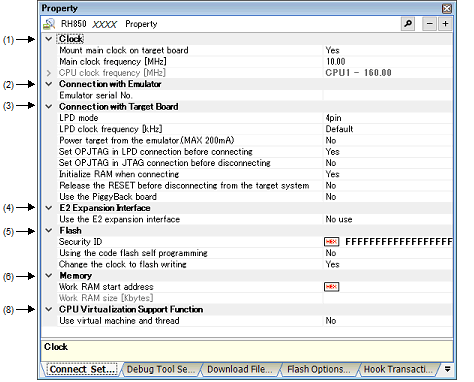This tab is used to display the detailed information categorized by the following and the configuration can be changed.
(2) [Connection with Emulator] [E1] [E20]
(3) [Connection with Target Board] [Full-spec emulator][E1][E20]
(4) [E2 Expansion Interface] [E2]
(5) [Flash] [Full-spec emulator][E1][E20]
(6) [Memory] [Full-spec emulator][E1][E20]
(7) [Configuration] [Simulator]
(8) [CPU Virtualization Support Function]



[Description of each category]
The detailed information on clocks is displayed and its configuration can be changed.
If an attempt is made to connect the emulator when this category is blank, the serial number of the emulator that is found first by search will be automatically selected and connection is made. The serial number of the emulator that is automatically selected in such a case will not be saved in the project information. |
The detailed information on the connection to the target board is displayed and its configuration can be changed.
|
Select whether the target board is connected to Full-spec emulator. |
||||
|
Select the baud rate for LPD communication. This property appears only when the [LPD mode] property is set to [1pin]. |
||||
|
Specify the clock frequency for LPD communication. When [Default] is selected, the default value specific to the microcontroller is used in connection to the target board. This property appears only when the [LPD mode] property is set to [4pin]. |
||||
|
Select the interface for supplying the power to the target board from the emulator. |
||||
|
Select the power voltage supplied to the target board. This property appears only when the [Power target from the emulator (MAX 200mA)] property is set to [Yes]. |
||||
|
Select from the drop-down list. Select from the drop-down list or directly enter from the keyboard. |
||||
|
Directly enter the numbers ranged below |
||||
|
Select whether to start up the microcontroller in serial programming mode upon connection to the debug tool and change the option byte settings to select LPD connection. |
||||
|
Starts up the microcontroller in serial programming mode upon its connection to CS+. The debug tool then checks the OPJTAG byte and, if LPD is not selected, changes the setting to select LPD. After that, the microcontroller enters debugging mode (default). |
||||
|
Starts up the microcontroller in debugging mode upon its connection to CS+. The debug tool then checks OPJTAG and, if LPD is not selected, shows a message dialog box. |
||||
|
Select whether to change the option byte settings to select JTAG connection before disconnection of the debug tool. |
||||
|
Select from the drop-down list. Note that changes can be made only when the [Set OPJTAG in LPD connection before connecting] property is set to [Yes]. |
||||
|
Changes the option byte settings to select JTAG connection before disconnection of the debug tool. |
||||
|
Does not change the option byte settings before disconnection of the debug tool. |
||||
|
Select whether to initialize the RAM when connecting to the debug tool. |
||||
|
Select whether to enable the security function (ICU-S) when connecting to the debug tool. Once the security function is enabled, it cannot be disabled after that. |
||||
|
Enable the security function (ICU-S) when connecting to the debug tool. |
||||
|
Does not enable the security function (ICU-S) when connecting to the debug tool. |
||||
|
Release the RESET before disconnecting from the target system |
Select whether to release the RESET before disconnecting from the target system. |
|||
|
Release the RESET before disconnecting from the target system. |
||||
|
Does not release the RESET before disconnecting from the target system. |
||||
|
Select whether to use the PiggyBack board. Select [Yes] to use the PiggyBack board. The emulator may not started if a PiggyBack board is in use but [No] is selected. |
||||
The detailed information on the E2 expansion interface is displayed and its configuration can be changed.
|
Uses the E2 expansion interface by the power supplied from the target. |
||||
|
Uses the E2 expansion interface by the supplied power from the emulator. |
||||
The detailed information on the flash memory writing is displayed and its configuration can be changed.
The properties in this category may vary with the selected microcontroller. |
Selecting [Yes] may affect the peripheral system that is operating during a break because not only the CPU clock frequency but also the peripheral clock frequency changes. |
The detailed information on the memory is displayed and its configuration can be changed.
Since the contents of memory are saved and restored, this area can be used by the user program. However, the area allocated as the working RAM cannot be used in the following ways. |
For microcontrollers incorporating an Intelligent Cryptographic Unit Processor (ICUP), specify the LocalRAM area for the ICUP. For other microcontrollers, specify the LocalRAM area for CPU1. |